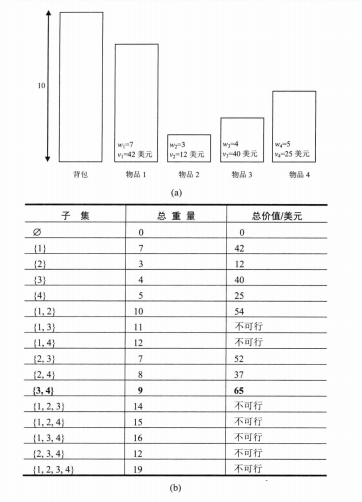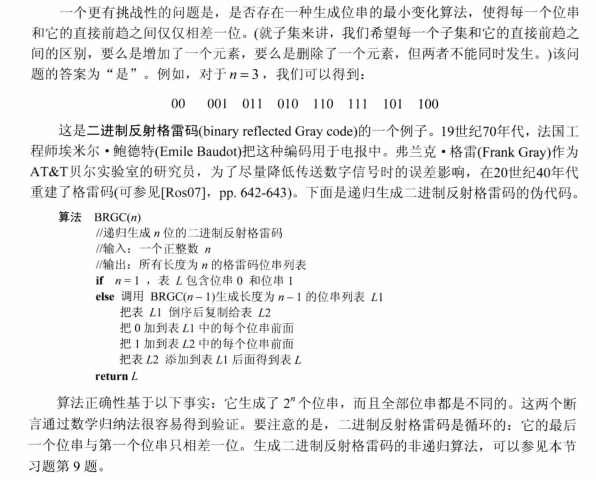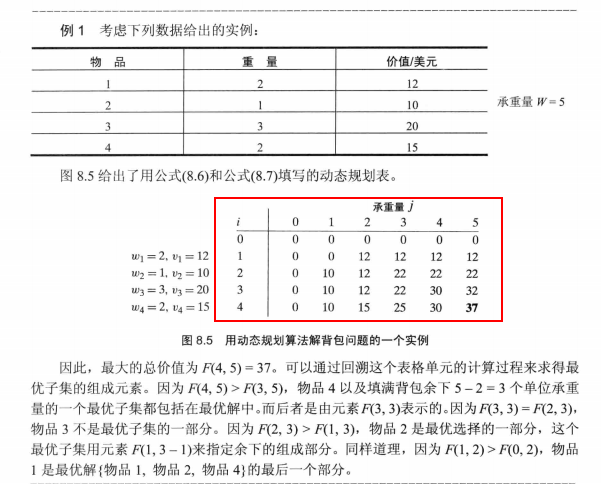算法笔记_019:背包问题(Java)
目录
1 问题描述
给定n个重量为w1,w2,w3,...,wn,价值为v1,v2,...,vn的物品和一个承重为W的背包,求这些物品中最有价值的子集(PS:每一个物品要么选一次,要么不选),并且要能够装到背包。
附形象描述:就像一个小偷打算把最有价值的赃物装入他的背包一样,但如果大家不喜欢扮演小偷的角色,也可以想象为一架运输机打算把最有价值的物品运输到外地,同时这些物品的重量不能超出它的运输能力。
2 解决方案
2.1 蛮力法
使用蛮力法解决包含n个物品的背包问题,首先得求出这n个物品的所有子集,对于每一个物品存在两种情况:选中(在程序中用1表示),未选中(在程序中用0表示)。该n个物品的所有子集数数量为2^n。下面请看一个简单示例:

此处,使用一个二维数组存放所有子集,数组的每一行代表一个子集,每一列代表一个具体物品。
package com.liuzhen.chapterThree; public class Knapsack { public int maxSumValue = 0; //定义满足背包问题子集的最大承重所得的总价值,初始化为0 /* * 数组A的行数为2^n,代表n个物品共有2^n个子集,列数为n。即每一行的排列为一个背包实例 * 数组weight存放每个物品的具体重量 * 数组value存放每个物品的具体价值 * n代表共有n个物品 * maxWeight表示背包最大承重量 */ public void bruteForce(int[][] A,int[] weight,int[] value,int n,int maxWeight){ for(int i = 0;i < Math.pow(2, n);i++){ //总共有2^n个子集,需要进行2^n次循环,及数组A有2^n行 int temp1 = i; for(int j = 0;j < n;j++){ //数组A有n列,每一列代表一个物品 int temp2 = temp1%2; A[i][j] = temp2; temp1 = temp1/2; } } printArray(A,weight,value,maxWeight); } //输出穷举方案的背包实例的选择物品(0代表不包含该物品,1表示包含该物品)的总重量及总价值,并输出最优实例的总价值 public void printArray(int[][] A,int[] weight,int[] value,int maxWeight){ int len1 = A.length; //二维数组的行数 int len2 = A[0].length; //二维数组的列数 for(int i = 0;i < len1;i++){ int tempWeight = 0; //暂时计算当前选中背包实例物品的总重量,初始化为0 int tempSumValue = 0; //暂时计算当前选中背包实例物品的总价值,初始化为0 for(int j = 0;j < len2;j++){ System.out.print(A[i][j]+" "); // if(A[i][j] != 0) // System.out.print(" 物品"+j); tempWeight += A[i][j]*weight[j]; tempSumValue += A[i][j]*value[j]; } System.out.print("\t"+"总重量为:"+tempWeight); if(tempWeight <= maxWeight) System.out.print("\t"+"总价值为:"+tempSumValue); else System.out.print("\t"+"不可行(超出背包最大承重)"); if(tempWeight <= maxWeight && tempSumValue > maxSumValue) maxSumValue = tempSumValue; System.out.println(); } System.out.println("穷举查找得知,最优解的总价值为:"+maxSumValue); } public static void main(String[] args){ Knapsack test = new Knapsack(); int[][] A = new int[16][4]; int[] weight = {7,3,4,5}; int[] value = {42,12,40,25}; test.bruteForce(A,weight,value,4,10); //背包的承重最大为10 } }
运行结果:
0 0 0 0 总重量为:0 总价值为:0 1 0 0 0 总重量为:7 总价值为:42 0 1 0 0 总重量为:3 总价值为:12 1 1 0 0 总重量为:10 总价值为:54 0 0 1 0 总重量为:4 总价值为:40 1 0 1 0 总重量为:11 不可行(超出背包最大承重) 0 1 1 0 总重量为:7 总价值为:52 1 1 1 0 总重量为:14 不可行(超出背包最大承重) 0 0 0 1 总重量为:5 总价值为:25 1 0 0 1 总重量为:12 不可行(超出背包最大承重) 0 1 0 1 总重量为:8 总价值为:37 1 1 0 1 总重量为:15 不可行(超出背包最大承重) 0 0 1 1 总重量为:9 总价值为:65 1 0 1 1 总重量为:16 不可行(超出背包最大承重) 0 1 1 1 总重量为:12 不可行(超出背包最大承重) 1 1 1 1 总重量为:19 不可行(超出背包最大承重) 穷举查找得知,最优解的总价值为:65
2.2 减治法
2.2.1 递归求解
背包问题的实质是求取n个不同物品的所有子集,在此基础上寻找重量合适,总价值最大的子集。此处只给出如何求出n个不同物品的所有子集实现,至于如何寻找符合背包问题的子集,感兴趣的同学可以自己动手实现以下哟~
此处是运用减治法思想,根据二进制反射格雷码的算法思想,来实现此问题。具体解释,请看下面一段出自《算法设计与分析基础》第三版上讲解:

具体代码如下:
package com.liuzhen.chapter4; import java.util.LinkedList; import java.util.List; public class GrayCode { //递归求取n个不同物品的所有子集 public String[] getGrayCode2(int n){ int len = (int) Math.pow(2, n); String[] result = new String[len]; if(n == 1){ result[0] = "0"; result[1] = "1"; return result; } String[] temp = getGrayCode2(n-1); //递归求取n-1个不同物品的所有子集 for(int i = 0;i < temp.length;i++){ //根据格雷码去掉最高位,前一半和后一半二进制数完全一样的对称性 result[i] = "0" + temp[i]; //前一半格雷码,最高位为0 result[result.length-1-i] = "1" + temp[i]; //后一半格雷码,最高位为1 } return result; } public static void main(String[] args){ GrayCode test = new GrayCode(); String[] temp2 = test.getGrayCode2(3); System.out.println("使用递归求解n个物品所有子集结果如下:"); for(int i = 0;i < temp2.length;i++) System.out.println(temp2[i]); } }
运行结果:
使用递归求解n个物品所有子集结果如下:
000
001
011
010
110
111
101
100
2.2.2 非递归求解(运用异或运算)
此处也使用求取格雷码的思想,完成求取n个物品的所有子集,不过此处是使用非递归来实现,运用异或运算,其构造非常巧妙,个人感觉要理解这种编码方式和思想得多多运用,直至熟能生巧。
具体代码如下:
package com.liuzhen.chapter4; import java.util.LinkedList; import java.util.List; public class GrayCode { //运用异或运算得到n个不同物品的所有子集 public List<Integer> getGaryCode1(int n){ List<Integer> result = new LinkedList<>(); if(n >= 0){ result.add(0); int top = 1; for(int i = 0;i < n;i++){ System.out.print("result.size() = "+result.size()+" "); for(int j = result.size()-1;j >= 0;j--){ System.out.print("result.get("+j+")^top = "+result.get(j)+"^"+top+" = "+(result.get(j)^top)+" "); result.add(result.get(j)^top); //符号‘^’是异或运算(使用具体数字的二进制进行运算),即1^0=1,0^1=1,0^0=0,1^1=0 } System.out.println(); top <<= 1; //top二进制左移1位,相当于top=top*2 System.out.println("top = "+top); } } return result; } //把十进制数转换成长度为n的二进制数 public StringBuffer[] getBinary(List<Integer> A,int n){ StringBuffer[] result = new StringBuffer[A.size()]; for(int i = 0;i < A.size();i++){ int temp1 = A.get(i); int judge = n; char[] temp2 = new char[n]; //用于存放temp1的n位二进制数 while(judge > 0){ int temp3 = temp1%2; temp2[judge-1] = (char) (temp3+48); //对照char的unicode编码,把int型数字转换为char型 temp1 = temp1/2; judge--; } result[i] = new StringBuffer(String.valueOf(temp2)); } return result; } public static void main(String[] args){ GrayCode test = new GrayCode(); List<Integer> temp = test.getGaryCode1(3); System.out.println(temp); StringBuffer[] temp1 = test.getBinary(temp, 3); for(int i = 0;i < temp1.length;i++) System.out.println(temp1[i]); } }
运行结果:
result.size() = 1 result.get(0)^top = 0^1 = 1 top = 2 result.size() = 2 result.get(1)^top = 1^2 = 3 result.get(0)^top = 0^2 = 2 top = 4 result.size() = 4 result.get(3)^top = 2^4 = 6 result.get(2)^top = 3^4 = 7 result.get(1)^top = 1^4 = 5 result.get(0)^top = 0^4 = 4 top = 8 [0, 1, 3, 2, 6, 7, 5, 4] 000 001 011 010 110 111 101 100
2.3 动态规划法
此处编码思想主要参考自《算法设计与分析基础》第三版的一段讲解,具体如下:



具体代码如下:
package com.liuzhen.chapter8; public class MFKnapsack { /* * 参数weight:物品1到物品n的重量,其中weight[0] = 0 * 参数value:物品1到物品n的价值,其中value[0] = 0 * 函功能:返回背包重量从0到所有物品重量之和区间的每一个重量所能达到的最大价值 */ public int[][] getMaxValue(int[] weight, int[] value) { int lenRow = weight.length; int lenColumn = 0; for(int i = 0;i < weight.length;i++) lenColumn += weight[i]; int[][] F = new int[lenRow][lenColumn+1]; //列值长度加1,是因为最后一列要保证重量值为lenColumn for(int i = 1;i < weight.length;i++) { for(int j = 1;j <= lenColumn;j++) { if(j < weight[i]) F[i][j] = F[i-1][j]; else { if(F[i-1][j] > F[i-1][j-weight[i]] + value[i]) F[i][j] = F[i-1][j]; else F[i][j] = F[i-1][j-weight[i]] + value[i]; } } } return F; } public static void main(String[] args) { MFKnapsack test = new MFKnapsack(); int[] weight = {0,2,1,3,2}; int[] value = {0,12,10,20,15}; int[][] F = test.getMaxValue(weight, value); System.out.println("背包承重从0到所有物品重量之和为8的承重能够达到的最大价值分别为:"); for(int i = 0;i < F.length;i++) { for(int j = 0;j < F[0].length;j++) System.out.print(F[i][j]+"\t"); System.out.println(); } } }
运行结果:
背包承重从0到所有物品重量之和为8的承重能够达到的最大价值分别为:
0 0 0 0 0 0 0 0 0
0 0 12 12 12 12 12 12 12
0 10 12 22 22 22 22 22 22
0 10 12 22 30 32 42 42 42
0 10 15 25 30 37 45 47 57
参考资料:
1. java实现格雷码生成
2.背包问题九讲
3.《算法设计与分析基础》第3版 Anany Levitin 著 潘彦 译

